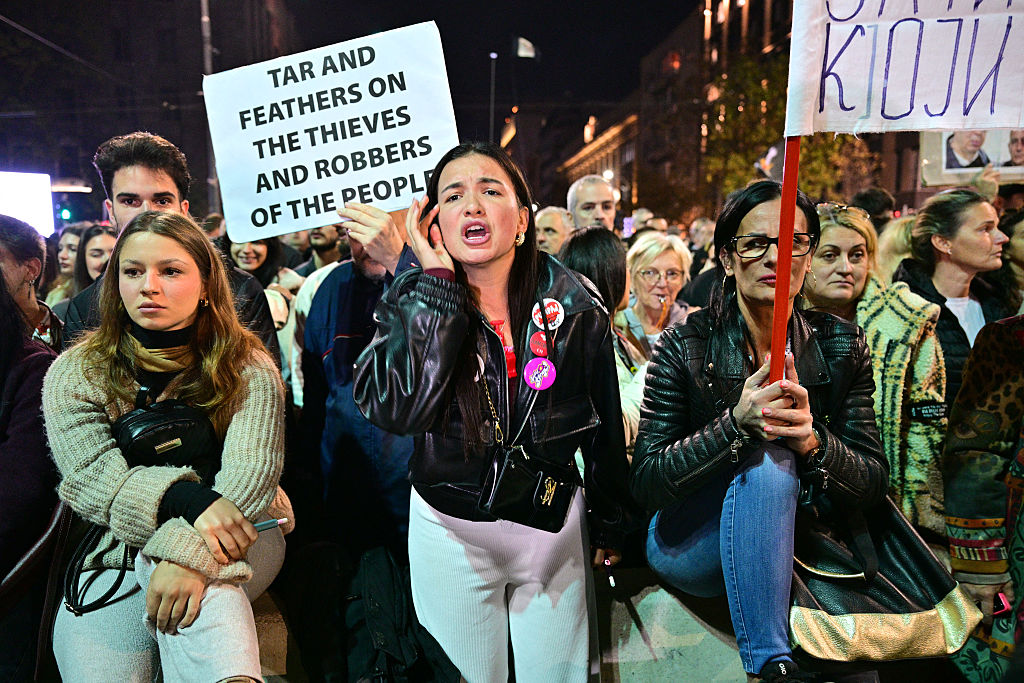Serbia’s Protests Have Destabilized Aleksandar Vučić’s Rule
A student-led protest movement has kept Serbian president Aleksandar Vučić under pressure for a full year. By refusing to bow in the face of intimidation, the protesters have exposed the corrupt authoritarianism of Vučić’s government.

More than 100,000 people gathered in the Serbian city of Novi Sad this month to mark the anniversary of a disaster that exposed high-level corruption. The government is still doing its best to cover up the truth. (Andrej Isakovic / AFP via Getty Images)
As I was scrolling through the New York Times app recently, a paid post appeared on my phone screen. The title in bright green letters placed over Belgrade’s city skyline at dusk announced: “Ready, Set, Play: Belgrade Gears Up to Show the World Its Creative Spirit.”
What a coincidence, I thought, and how cynical! That morning, I had been looking in vain on the same app for any updates from my country that has now been in turmoil for a year.
The day before, on November 1, Novi Sad saw the largest protest gathering in its history as more than a hundred thousand people congregated in the city, sixty miles north of Belgrade, to commemorate the anniversary of a disaster. Student-led protests have been going on over the past twelve months throughout Serbia, reaching its high point on March 15, when over 250,000 people protested on the streets of Belgrade.
When part of the newly renovated railway station’s roof collapsed a year previously, it killed sixteen passersby, including two children. The action on November 1 was not merely a commemoration of those who lost their lives: the mourners were also protesting the inaction of the Serbian authorities over the tragedy.
Under Siege
On August 1, the Public Prosecutor’s Office for Organized Crime charged a group of individuals who were connected with the reconstruction of the railway station in Novi Sad, including the former government ministers Goran Vesić and Tomislav Momirović. They are accused of embezzling more than $115 million from the funds dedicated to this infrastructure project. This confirmed a widely held belief that the fatal collapse was caused by an elaborate government corruption scheme, with mounting evidence pointing toward the very top levels of government.
The paid post in the New York Times paints a rosy picture of the Serbian capital. Yet if someone took this picture in earnest and went to Belgrade themselves, they would find the city in upheaval. For the last year, students and other citizens have been demanding justice for the victims of the Novi Sad tragedy. They have pointed the finger at high-placed members of the ruling coalition who have been involved in multiple shady business deals, including an illegal marijuana farm on the outskirts of Belgrade.
An unsuspecting visitor to Belgrade would not encounter the place that the informercial described as “a multiple-exposure photo capturing a rich mix of eras.” Since March, the large plaza in front of the Serbian Parliament building has been occupied by military-style tents housing men in dark outfits who support the regime of President Aleksandar Vučić.
The paid post quotes one Slobodan Trkulja, introduced as a musician, who explains that in Serbia, “we like to party, we like music, we love to dance.” At the moment I was reading this post, one could have heard warmongering nationalist songs blaring from the tent encampment, trying to intimidate Dijana Hrka, the mother of a twenty-seven-year-old Stefan Hrka, who was killed in the canopy collapse. That afternoon, she started a hunger strike in front of the parliament building, asking for justice for her son’s death.
During the night, a group of students who supported her were arrested, joining dozens of protesters who suffered the same fate over the past year. Meanwhile, the corruption case is still stuck in the channels of Serbia’s notoriously inefficient justice system. While the two former ministers are under house arrest, news reports indicate that they are still pursuing business deals.
Media War
Someone may object that there is no point in taking an advertisement seriously. After all, their purpose is to embellish and prettify the product they are selling rather than present a realistic image. In this case, the problem concerns both the product and its peddler.
Vučić, who has now been at the helm of the Serbian state for twelve years, was a high-ranking official of the ultranationalist Serbian Radical Party during the Yugoslav wars of the 1990s. He served as the minister of information in Slobodan Milošević’s government during the latter’s bloody rampage in Kosovo, which ended with the NATO bombardment of the country in 1999. Throughout that destructive decade, the regime blamed the negative perception of Serbia abroad on a “media war,” which it claimed it had lost, rather than the war crimes committed by the paramilitaries it supported in Bosnia and Croatia.
The former information minister is now using the money of Serbian taxpayers to wage a “media war” of his own. The paid post advertised Belgrade Expo 2027, a controversial infrastructure scheme characterized by secretive government contracts, undisclosed business arrangements, and a complete absence of public oversight.
It came shortly before a parliamentary session called on November 4, in which the governing coalition bulldozed through a special law. The law facilitates a hotel construction project involving Donald Trump’s son-in-law Jared Kushner — a project that is also chockful of administrative irregularities.
The Serbian regime is taking advantage of the lack of reporting about the ongoing turmoil in international media outlets. That neglect is helping Vučić and his cronies to win the “media war” in defense of their shady business dealings. For now, it is the citizens of Serbia who are paying the price for such corruption, including those who have lost their lives.